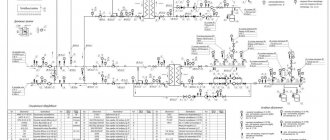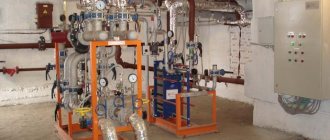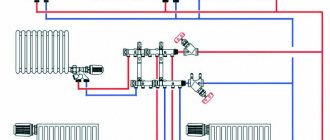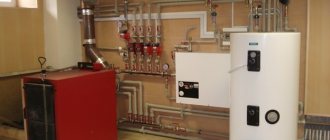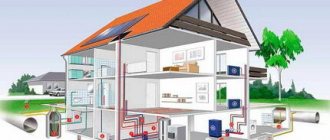It happens that private houses located within the city are located next to central heating networks, and some are even connected to them. Of course, nowadays the priority is individual heating, and centralized heating is gradually becoming a thing of the past. But if the house is already connected to the network or there are problems with the autonomous system, then you need to use what is available. To work together between a heat source and consumers, a dependent and independent heating system is used. What they are, as well as the pros and cons of both schemes will be outlined in this material.
Connection options
Currently there are two main connection schemes:
- dependent - considered the simplest, therefore most often used;
- independent - gained popularity relatively recently; it is widely used in the construction of new residential areas.
Below we will look at each method in more detail to find out which solution will be the most effective for ensuring comfort and coziness in your room.
Dependent connection method
This connection option usually requires the creation of in-house heating stations, often equipped with elevators. In their mixing unit, superheated water from the external main network is mixed with the return water, which allows it to be reduced to the required temperature, usually below 100 °C. Thanks to this, the heating system inside the house is completely dependent on external heat supply.
| Advantages | The main feature of the scheme is that water enters the heating and water supply system directly from the heating main, so the costs in this case pay off in a short time:
|
| Flaws | As in any scheme, here you can find not only positive aspects, but also negative ones, among which it should be noted:
|
Connection methods:
- direct connection
; - with elevator
; - with on the jumper
; - with mounting of a pump on the supply or return
; - combined option - elevator and pump
.
Independent connection method
Experts say that this heat supply option makes it possible to reduce resource costs by almost 40%.
In today's situation with their constant rise in price, this will significantly save money in the family budget.
- The operating principle is as follows:
- connection of the heating system of subscribers is made using an additional heat exchanger;
- heating occurs thanks to two hydraulic isolated circuits - the main heating main heats the coolant of the closed internal heating network;
- in this case, no mixing of water occurs.
- The coolant circulates in the heating mechanism due to a circulation pump, which regularly supplies it through the heating elements. An independent connection scheme may provide an expansion tank with a supply of water in case of leaks. In this case, it is possible to maintain the circulation of the coolant with a certain amount of heat even in the event of a heating main failure. In fact, this means that if the supply of hot water through the heating main stops, the temperature in the heated rooms will not drop sharply for a long time.
- The scope of application of this connection method is quite wide. For example, it is used:
There is one condition - the pressure in the return must be more than 0.6 MPa.
- Advantages of the method:
- the instructions allow you to adjust the temperature;
- great energy saving effect.
- Flaws:
- high price;
- complexity of repair and maintenance work.
Comparison of schemes
- The dependent option has one important advantage - low implementation cost. An elevator unit in a small country house is easily assembled with your own hands from shut-off valves, which can be purchased in a store or on the market. The only expensive part will be the nozzle, on which the power of the elevator depends.
- An independent scheme allows you to:
- adjust the coolant temperature;
- increase the efficiency of use, bringing this level to 40%;
- Large amounts of contaminants, such as scale, sand and mineral salts, do not enter the heating system. The coolant can be purified water or antifreeze liquids.
- You can easily heat clean drinking water for hot water needs.
Dependent connection
It can be performed in two versions: directly or using a mixing unit. If the connection is made according to the first option, then the superheated water from the heating networks is mixed in the boiler (in a certain volume) with the returning water from the heating system. In this way, the water acquires a sufficient temperature, up to approximately 100 0. Its value depends on the power of the boiler. The temperature may be higher. Next, it enters the heating source. Heating points are supplied with pumping mixing devices and water-jet elevators. To create an optimal indoor air temperature, low-temperature water is added to the pipeline, reducing the temperature. The second connection option implies that hot and cold water are mixed, and the coolant fluid with a temperature of 70-80 0 C is sent to the heating radiators of residential buildings.
Dependent connection diagram. Click on photo to enlarge.
Direct connection can be used directly in low temperature heating networks, where a two-pipe system with radiator throttling thermostats is installed. Here, the coolant parameters are constant throughout the year. Heat networks reflect changes in consumer demand for heat volume through instruments showing the pressure drop at the inputs. With their help, electronic regulators change the flow of general pumps in the heating network.
This system can only be regulated quantitatively. The circulation of the heat source of the dependent circuit is carried out through differences in the water pressure in the areas of connection to the elements of the external heating system. The dependent connection and its connection diagram with the water mixing unit are structurally simple and easy to maintain.
The cost of the circuit is greatly reduced by eliminating some structural elements. A dependent circuit is selected if the heat-consuming system, including the heating system (according to sanitary and hygienic recommendations) allows an increase in hydraulic pressure to the value of the water pressure from the outside when entering the heat pipeline. For some time, the dependent scheme was popular in Russia, due to the ratio of its pros and cons.
Independent heating system unit. Click on photo to enlarge.
Comparison of reliability and durability
The practice of operating technically complex and multi-level systems shows that they are less maintainable and more often must be subject to preventive inspections with maintenance measures. It cannot be said that independent connection of the heating system reduces the overall level of reliability and safety (in some cases it even increases it), but the tactics for carrying out repair and restoration activities should be at a different and more responsible level.
At a minimum, an increase in labor and time resources will be required when inspecting the heat exchanger and adjacent piping. Possible uncontrolled accidents at this site can lead to damage to the pipeline. Therefore, experts recommend installing several sensors that monitor pressure, temperature and tightness. The latest manifold cabinets also provide for the use of self-diagnostic systems for continuous monitoring of the system condition. As for the closed heating infrastructure, such control and measuring equipment will also not be superfluous, but in this case its need is not so high.
Which system is justified in a private home?
For a private home, a combination boiler, for example, electricity/gas, is suitable.
For industrial workshops and houses above 12 floors, an independent gravity system is used - it ensures the quality of heating due to the uniform distribution of heat. The costs of equipment and installation activities pay off if there is a large area. The calculations and selection of the scheme are carried out by specialists. They recommend installing several heat exchangers to heat the primary, secondary coolant and DHW mains.
In the conditions of villages, dachas, and small enterprises, the technological features of heat supply are taken into account. There is practically no central heating in such places - individual heating is often used, with a separate boiler room. It needs to be equipped taking into account energy independence. For this purpose boilers are used:
- Pellet. They contain special homogeneous granules - pellets made from pressed shavings or husks. The owner loads fuel for several days; electricity is used only to power the screw motor.
- Pyrolysis. They work on the principle of afterburning gases in a secondary chamber. They run on electricity, from generators. The air is pumped through special valves.
- With top combustion. The fuel is piled up and ignited from above.
- With forced air supply. Pellets or firewood are placed in a large single-chamber firebox. The blower contains a fan and a damper that blocks air access.
The best option for a private home is a boiler, but it will require 20% more fuel compared to central heating.
Pros of independent systems
Already at the approach to the main consumers of the home water supply network, a whole range of preparatory measures is provided to ensure distribution, filtration and adjustment of coolant pressure. All loads fall not on the final equipment, but on the heat exchanger with a hydraulic tank, which directly receive resources from the main source. Such resource preparation is practically impossible on a private basis when operating dependent heating systems. Connecting an independent circuit also allows you to rationally use water for drinking needs for optimal purification. Streams are divided according to their intended purpose and each line can provide a separate level of preparation that meets technological requirements.
Independent heating system
A fundamental feature of this system is the presence of an intermediate collection point. In private residential buildings, it can be implemented as a regulating station (including for reducing pressure), but the integration of a heat exchanger makes this scheme independent. It performs the functions of rational and balanced redistribution of hot flows, also maintaining, if necessary, optimal temperature conditions. That is, with an independent connection of the heating system, the heating network as such does not act as a direct source of supply, but only directs flows to an intermediate technological point. Then, in accordance with the settings made, in a more targeted version, it can supply both drinking water and hot water for heating and other household needs.
Saving resources
The dependent type of closed system provides that water flows to the consumer without passing through heating points. In this case, there is no need to install circulation pumps, devices for regulating heat exchange and automatic control. But there is also a minus - the inability to regulate the temperature in the system.
Independent closed heating systems save energy resources in the amount of 10-40% per year. They allow you to regulate the amount of heat supplied, the temperature of the coolant and improve its quality characteristics, which leads to reliable operation of heating equipment.
An example of an open heating system in the video:
Which heating scheme is better?
There is another drawback with gas non-volatile heating boilers - they do not have the ability to control the weather and control the unit using an external thermostat, which determines the temperature regime, for example, in the most remote room. Accordingly, it is not possible to program the temperature for a long period, for example, two weeks.
About the types of heating systems in detail in the video:
In apartment buildings, the overwhelming majority use the central heating network for heating. However, the quality of such services depends on many factors, including the condition of the heating main and equipment. The connection diagram of the house to the heating network is also important. In this case, you will learn about dependent and independent connection methods, as well as how to make heating in an apartment energy-independent.
Gas boilers
A gas boiler can also be non-volatile. This model works according to the following principle: the user lights the pilot burner, which from that moment burns constantly. It lights up the main one.
All safety automation is mechanical, that is, its action is based on changes in the volume of materials when the temperature changes.
Double-circuit gas boiler
The disadvantage of a non-volatile gas boiler is the following: the pilot burner, although seemingly quite small, consumes quite a lot of gas. Much more economical are energy-dependent boilers that have electronic ignition.
Dependent heating system
The central link of such communications is the elevator unit, through which the tasks of regulating the coolant are performed. From the heating main to the distribution unit of a residential building, water is supplied through a pipeline, and mechanical control is carried out by a system of inlet gates and valves - standard plumbing fittings. At the next level there are locking mechanisms that regulate the supply of hot water to the return and input circuits. Moreover, the heating system in a private country house may include two connections - for the return line and the supply channel. Next, after the home taps, there is a chamber in which the coolants are mixed. Hot streams can indirectly contact water in the return circuit, transferring some of the heat to it. Summarizing this part, we can conclude that water is sent to the hot water supply system directly from the central heating main.
Heating network pipes
Currently, domestic ones are in disrepair. Due to the high wear and tear of communications, it is cheaper to replace the pipes for the heating main with new ones than to engage in constant repairs.
It is impossible to immediately update all old communications in the country. During the construction or major renovation of houses, new pipes are installed to reduce heat loss several times. Pipes for the heating main are made using a special technology, filling the gap between the steel pipe located inside and the shell with foam.
The temperature of the transported liquid can reach 140°C.
Using polyurethane foam as thermal insulation allows you to retain heat much better than traditional protective materials.
Terminology
Let's clear up the confusion first.
Energy independence
- this is the ability of heating equipment to operate in the absence of electricity. The ability is undoubtedly pleasant, but we are not talking about it now. However, we will also touch on this topic.
What is the difference between independent and dependent heating systems? Connection diagram to the heating main.
Dependent circuit
Imagine an ordinary residential building. How is it built?
- Input valves cut off the elevator from the route.
- Behind them, on the supply and return lines, there are valves or valves embedded through which hot water can be supplied from the supply or return pipeline.
- After the hot water supply inserts, we see the elevator itself - a nozzle with a mixing chamber. A stream of hotter, high-pressure water from the direct pipeline heats up part of the return water and draws it into recirculation.
- Finally, house valves cut off the heating system. They are closed in summer and open in winter.
The key feature of a dependent heating scheme is that water enters the heating and water supply systems directly from the heating main.
Independent circuit
Now let's imagine another diagram:
- Water from the supply pipeline enters the return pipeline, giving energy to the heat exchanger along the way. Water, we repeat, is not used for heating and hot water needs.
- Drinking water from the water supply is supplied to the same heat exchanger, but to a different circuit. It heats up and enters the heating system. It can also be used for household needs.
Actually, we have comprehensively described the independent connection scheme for the heating system.
conclusions
In current conditions, the best way to fully heat a country house without gas or electricity is to burn solid fuel in boilers or stoves. The main role here is played by the combination of the cost of heating installations and the price of firewood, coal and other briquettes with pellets. Other options will cost more.
An economically advantageous energy source in our conditions is firewood.
Please note that when choosing thermal power equipment, a simple rule applies: the smaller the initial cash investment, the more troublesome its operation. Any homeowner who wants to organize super-economical heating at a low price must invest more work and time. Conversely, when purchasing and installing expensive heat pumps, the owner of the house is left with one concern - sometimes monitoring the temperature and monitoring the operation of the units.
Comparison of solutions
The dependent heating connection scheme has, in essence, only one advantage, but a very important one - low cost of implementation. You can assemble an elevator unit for a small cottage with your own hands from consumer-grade shut-off valves
The only thing noticeable against the background of wiring batteries around the house will be the cost of manufacturing the nozzle - the only exclusive one made, the diameter of which determines the thermal power of the elevator.
What are the assets of an independent scheme?
Incomparably more flexible temperature control. It is enough just to reduce the flow of coolant through the heat exchanger - and the house will become colder.
- The practical consequence of flexible adjustment of heating to the needs of the home is efficiency.
Relative to the dependent system, it is estimated at 10-40 percent. - Finally, the main thing: in a dependent system we are forced to use water with a lot of pollution.
It carries sand, scale and a lot of mineral salts.
There is no talk of using water as drinking water; moreover, in some regions it is undesirable to even wash with hot tap water. An independent circuit makes it possible to use purified water or even non-freezing coolants as a coolant.
It is not a problem to heat drinking water for DHW needs.
Electricity addiction
Now let's return to energy dependence. When does a heating system need electricity to function, and when can it be done without?
Solid fuel boilers
The canonical solution is a conventional steel or cast iron boiler with a water jacket in the firebox and mechanical adjustment of the blower using a thermostat. This unit is completely energy independent.
The photo shows a classic solid fuel boiler.
However, this design has an important drawback: the boiler requires frequent loading of fuel. Three technical solutions allow you to make heating as independent from humans as possible:
- A hopper and a conveyor belt
supply new portions of sawdust or pellets as the fuel burns out. Electricity is required at a minimum for the transporter to operate. - divides combustion into two stages: pyrolysis of wood with a limited supply of oxygen and combustion of the resulting gas. In this case, the gas combustion chamber is located below the pyrolysis chamber. The movement of combustion products against the vector of natural draft requires the operation of an electric fan.
- An upper combustion boiler
can operate on one load of coal for up to five days. Only the top layer of fuel smolders; air is supplied to it from top to bottom, and the ash is carried away by a stream of hot combustion products. Air circulation is provided by... that's right, an electric fan.
Gas
Non-volatile gas heating boilers use manual ignition using a piezoelectric element and flame regulation by a mechanical thermostat. When the main burner is extinguished at a high coolant temperature, the pilot burner continues to operate.
Boilers with electronic ignition stop the gas supply completely when idle. As soon as the coolant cools below the critical temperature, the discharge ignites the main burner and heating resumes. In addition, electricity often drives a blower fan that supplies air to the burner.
Which scheme is better? If you have frequent power outages, a non-volatile gas heating boiler would be more appropriate. Precisely because he is able to do without electricity in principle. On the other hand, these devices are less economical: up to 20% of the total gas consumed is spent maintaining the pilot flame.
Another useful feature that gas-independent heating boilers lack is the ability to control the weather and control it using an external thermostat, which takes the temperature, for example, in a remote room. Of course, we are also not talking about programming the temperature for a day or a week.
Solara
Everything is simple here: solar boilers are COMPLETELY identical to gas boilers with electronic ignition. Only the burners differ. In fact, a lot of dual-fuel units are being produced.
It is clear that without a forced-air fan and electronic ignition, the devices simply will not be able to work.
Features of work
The transition to a closed system requires financial investments, but these investments pay off in the future. The decision to make the transition is made by the overwhelming majority of companies providing heat supply services to the population. The organization of heat supply work is constructed in various ways; there may or may not be dependence on electrical energy.
A steel or cast iron boiler running on solid fuel can be used as a heat generator. The constant loading of flammable material becomes a significant disadvantage, however, compared to the temperature loss during a power outage, this does not seem to be a serious problem.
To ensure independent heating in a private home, the following technical solutions will help:
- bunker and transport belt (supply of firewood or sawdust, minus - the belt requires electricity to operate);
- pyrolysis boiler (solid fuel is burned at the first stage, and the resulting gas is burned at the second stage);
- top combustion boiler (capable of operating for about 5 days on one burner, a fan is required for operation).
It is impossible to automate the heating system using these methods without the use of electrical energy. An alternative is gas boilers equipped with a mechanical thermostat. If the temperature is lost, the gas supply and heating of the coolant are resumed.
The advantage of an independent heating scheme over an open one is clear, but there are nuances in organizing such a system. Options for creating heat supply using a closed model are characterized by diversity. There is no universal solution; for each specific case, special approaches are practiced; consultations with professionals will help you choose the appropriate option.
Safety and efficiency of independent heating systems
To be able to save money on heating, several conditions must be met:
- Develop and approve the project with the permitting authorities. Without an approved GIP and a project agreed upon with all authorities, all modifications will be illegal. Therefore, you will not be able to use the results.
- Install or reconstruct existing equipment according to the design solution.
- Install a heat energy meter. This will allow you to pay for the received thermal energy exactly in the volume in which it was consumed.
- Provide the necessary level of automation or manual regulation. CHP plants do not respond particularly quickly to temperature changes in weather conditions and can continue to fire their boilers to the fullest. And through the heat exchange tank, unclaimed energy will be transferred to the networks of consumers who open windows and vents from excess heat.
Installation and connection of an independent heating system
Installation work is not much more complex than a gravity route. Among the additional measures, it is worth noting the need to organize an uninterruptible power supply. This will make it possible not to be left without heat during a power outage and is implemented by automatically turning on a battery-powered uninterruptible power supply or a liquid fuel electric generator.
In addition, existing centralized routes are also subject to modernization by separating coolants with a heat exchange tank, installing a forced circulation pump and an uninterruptible power supply. Replacement or dismantling of pipelines with radiators is not required.
There are two types of schemes by which heating devices are connected. Depending on the use of the circuit, two types of heat supply systems are distinguished - dependent and heat supply.
The meaning of an independent heat supply system is that the subscriber's equipment is isolated from the heat supplier using hydraulics. And in order to provide subscribers with heat, auxiliary exchangers of central heating points are needed.
In the case of using a dependent system, it is necessary to constantly connect it to the energy carrier. Such a system consists of pipes and a boiler, which are interconnected into one whole. The meaning of a dependent heat supply system is to circulate hot water in a circle in a continuous mode. Due to the fact that the dependent system is completely tied to the heating main, which is the main source of thermal energy, when using it it is impossible to adjust the water temperature or even, in case of warming, turn off the heating.
Diagram of a dependent heating system
When using an independent heating system, different types of fuel can be used. It should be noted that installing such a system is quite expensive. Unlike a dependent system, in an independent system water can be used for other needs. Another advantage is that the independent one is much easier to install in a building.
Among other things, such a system makes it possible to save money due to the fact that its operation requires a small amount of fuel. The amount of fuel can be adjusted at will, thereby creating comfortable conditions in the premises.
Diagram of an independent heating system
Principle of operation
As noted above, for the operation of the dependent system, process water is used, which during operation leaves salts and sand in the pipes, which disrupts the permeability of water in the pipes. In the case of independent, it is possible to use purified. In this case, the equipment can be shown to have a fairly long service life.
An independent heating system can do without electricity. It may only be needed if a bunker and conveyor are installed in order to supply fuel to the boiler.
You can also use a boiler operating with. Such boilers are a structure consisting of mechanical, thermostat, and steel tanks. Such a system does not tie you to the gas main.
Forced circulation
Neutralization of almost all of the listed disadvantages is achieved by introducing a circulation pump into the system.
As a result, the coolant receives an additional impulse, thanks to which it effectively overcomes the hydraulic resistance of the pipeline. Single-pipe heating system wiring is currently the most popular solution in private homes. The installation location for the pump can be any section of the highway. However, it should be borne in mind that when rubber elements (gaskets) are exposed to hot water, the service life of the pump is noticeably reduced. Therefore, they try to install the device on the return pipe, because The coolant there is not so hot. A coarse filter must be installed in front of the pump to prevent various contaminants from entering the mechanism. When connecting all instruments and devices, it is recommended to use shut-off valves and bypasses. This will significantly simplify repair and maintenance activities at individual units: in this case, there is no need to stop the entire system and completely drain the coolant.
Strengths of forced circulation heating circuits:
- Possibility of using more complex branched circuits, leading to an increase in the total length of the circuits.
- There is no need to increase the diameter of the pipes. Thanks to the pump, sufficient pressure is created inside the system for movement and uniform distribution of liquid.
- The circulation has a stable speed. This indicator is not affected by the level of heating of the coolant and the installation of the accelerating manifold.
- There is no need to organize inclination angles on horizontal sections of the pipeline, because A pump is used to stimulate the movement of the coolant.
- It becomes possible to insert control devices on all batteries, which ensures the maintenance of an optimal heating level, reducing energy consumption and heating costs.
There are also disadvantages:
- The need for electrical power.
- Noise from a running pump.
- The need for additional capital investments (when compared with the gravity scheme).
Neutralizing them usually does not cause difficulties. To maintain a stable energy supply, an autonomous electric generator is being installed. Systems that provide the possibility of switching to a natural circulation mode have proven themselves very well. To reduce the noise from a running pump, it is usually installed in a non-residential area.
Dependent heating system
A dependent system is often called an open system. And it is called that because a heat carrier is taken from the supply pipe to provide the house with hot water. The dependent circuit is often used in administrative, multi-apartment and other buildings that are intended for public use. The peculiarity of an open system is that the coolant flows through the main networks and enters directly into the house.
If the temperature of the coolant in the supply pipeline is no more than 95°C, then it can be sent to heating devices. But if the temperature exceeds 95°C, then it is necessary to install an elevator unit at the entrance to the house. With its help, water that comes from heating radiators is mixed into the hot coolant to lower its temperature.
Previously, no one paid special attention to coolant flow, so this scheme was often used. Dependent heating system does not require large installation costs
There is no need to lay additional pipes to provide your home with hot water.
But in addition to the above advantages, we can also highlight the disadvantages of a dependent heating system:
- Regulating the temperature in rooms is problematic. Valves quickly fail due to poor quality of the coolant.
- From the main pipes, various dirt and rust enter the heating radiators. Steel and cast iron radiators continue to operate without any changes. But in aluminum batteries, the ingress of rust and dirt has a detrimental effect on operation.
- Although the coolant undergoes all the required desalting and cleaning, it still passes through rusty main pipelines. Accordingly, the coolant cannot be of good quality. This factor is a big disadvantage, since the coolant is used for water supply.
- Due to repair work, pressure drops in the system or even water hammer often occur. Such problems can seriously affect the performance of modern heating radiators.
Types of circulation in heating circuits
To deliver heat to the batteries, you need to move the coolant heated by the boiler. Natural circulation is used in the heating system and forced movement of water using a circulation pump. Natural circulation is used in simple heating systems; it requires a minimum of equipment with minimal installation and operating costs.
To implement this method of moving the coolant, a change in the physical properties of water when heated is used. The speed of movement depends on the temperature difference and on the magnitude of hydraulic resistance, which is reduced by increasing the diameter of the pipes.
Open heating circuit
An open gravity heating system with natural circulation has undoubted advantages.
Advantages of open natural coolant circulation:
- simplicity and low installation costs;
- efficiency;
- easily converted into a system with forced circulation; the circulation pump is usually installed in the “return”.
Therefore, the heating system for a one-story house with natural circulation is very popular and is successfully used. The main disadvantages of such heating are high inertia. In addition, the presence of an open expansion tank determines the answer to the question - is it possible to pour antifreeze into the heating system of a house. You can fill it, but it will constantly evaporate, which will make the operation of the system unprofitable.
Closed heating circuit
The coolant in a closed heating system has no contact with atmospheric air. To compensate for thermal expansion, sealed membrane expansion tanks are installed. A closed heating system can have any design; it is equipped with a circulation pump to move the coolant. The absence of contact of the coolant with air significantly increases the service life of pipes and heating circuit equipment.
If during installation the slope of the pipes is provided, then in the absence of mains voltage and the bypass is switched, natural circulation will occur in the closed heating system of the house. Of course, the efficiency of the system will drop, but the heating will be operational and will continue to heat the home.
The main advantages of a closed heating system:
- the use of a sealed expansion tank eliminates the evaporation of liquid; in closed systems, antifreeze can be used as a coolant;
- the absence of contact between water and air protects circuit elements from internal corrosion;
- a closed heating circuit has low inertia and high efficiency;
- the use of a circulation pump allows you to reduce the diameter of the pipes and reduce the cost of purchasing them;
- for heated floors and complex branched circuits, an additional pump is installed in the heating system, which will ensure their efficient operation.
Dependent open heat supply system
The main feature of the dependent system is that the coolant flowing through the main networks directly enters the house. It is called open because coolant is taken from the supply pipeline to provide the house with hot water. Most often, this scheme is used when connecting multi-apartment residential buildings, administrative and other public buildings to heating networks. The operation of the dependent heating system circuit is shown in the figure:
When the temperature of the coolant in the supply pipeline is up to 95 ºС, it can be sent directly to the heating devices. If the temperature is higher and reaches 105 ºС, then a mixing elevator unit is installed at the entrance to the house, whose task is to mix the water coming from the radiators into the hot coolant in order to lower its temperature.
The scheme was very popular during the Soviet era, when few people were concerned about energy consumption. The fact is that the dependent connection with elevator mixing units works quite reliably and requires practically no supervision, and installation work and material costs are quite cheap. Again, there is no need to lay additional pipes to supply hot water to houses when it can be successfully taken from the heating main.
But this is where the positive aspects of the dependent scheme end. And there are many more negative ones:
- dirt, scale and rust from the main pipelines safely enter all consumer batteries. Old cast-iron radiators and steel convectors didn’t care about these little things, but modern aluminum and other heating devices definitely don’t;
- Due to a decrease in water intake, repair work and other reasons, a pressure drop in the dependent heating system, or even water hammer, often occurs. This has implications for modern batteries and polymer pipelines;
- The quality of the coolant leaves much to be desired, but it goes directly to the water supply. And, although the water in the boiler room goes through all stages of purification and desalting, kilometers of old rusty mains make themselves felt;
- Regulating the temperature in rooms is not easy. Even full-bore thermostatic valves quickly fail due to poor quality coolant.
Open Network Package
To assemble an open circuit, you will need the following elements:
- heating equipment;
- pipelines;
- atmospheric expansion tank;
- heating appliances;
- pumping equipment will only be needed for open-type water heating with a pump;
- drain valve;
- tap for filling the network with coolant.
Boiler
Open circuits can work with the following types of boilers:
- It is advisable to use gas heating equipment in regions where there are gas mains. Gas boilers are the most economical, but they are installed after obtaining permission from the gas service.
- Solid fuel units operate on wood, coal, pellets or briquettes. There are long-burning boilers on sale that are economical, efficient, and do not require frequent loading of fuel.
- Electric heaters are not used as often because energy resources are quite expensive.
- Combined type units can operate on two different types of fuel, which makes the equipment non-volatile.
Circulation pump
If we compare natural and forced circulation, the latter is much better because it increases the efficiency of the heating system. Despite the energy consumption of the pump, there is a saving in the energy carrier used by the boiler.
Pumping equipment is selected according to the diameter of the pipes at the insertion point, liquid pressure and productivity
When choosing a pump, pay attention to its technical characteristics
Expansion tank
You can make an expansion tank yourself or buy it. The stainless steel tank is equipped with an opening lid to control the coolant level. A pipe is installed in the upper part of the container to drain excess liquid.
The expansion tank can be installed at the following network points:
- on a remote riser;
- at the highest point of the system;
- on the return pipeline;
- together with pumping equipment that is installed on the supply pipes.
Heating radiators
Open heating can work with the following types of heating devices:
- Cast iron batteries are ideal for open systems because they have great inertia, which ensures energy savings.
- Steel radiators with anti-corrosion coating are lightweight and inexpensive, but it is better to avoid using them. The device cools down quickly, which will lead to frequent operation of the heater and excessive energy consumption.
- When choosing aluminum appliances, give preference to units with anti-corrosion coating. They are valued for their durability, good heat dissipation, light weight and attractiveness.
- The most expensive bimetallic devices. They combine the advantages of steel and aluminum appliances, but are completely devoid of their disadvantages. But they are better used in centralized networks with high pressure.
Pipes
For natural coolant flow, large diameter pipes will be needed.
Pipelines made of the following materials can be used:
- steel pipes are almost never used due to the complexity of installation and heavy weight;
- copper pipelines are the highest quality and most durable, but they are very expensive;
- metal-plastic pipes themselves are not bad, but they are connected to fittings that often leak;
- it is better to choose elements made of cross-linked polyethylene with oxidation protection and reinforcement;
- There is another inexpensive and practical option - polypropylene pipelines with fiberglass reinforcement.
